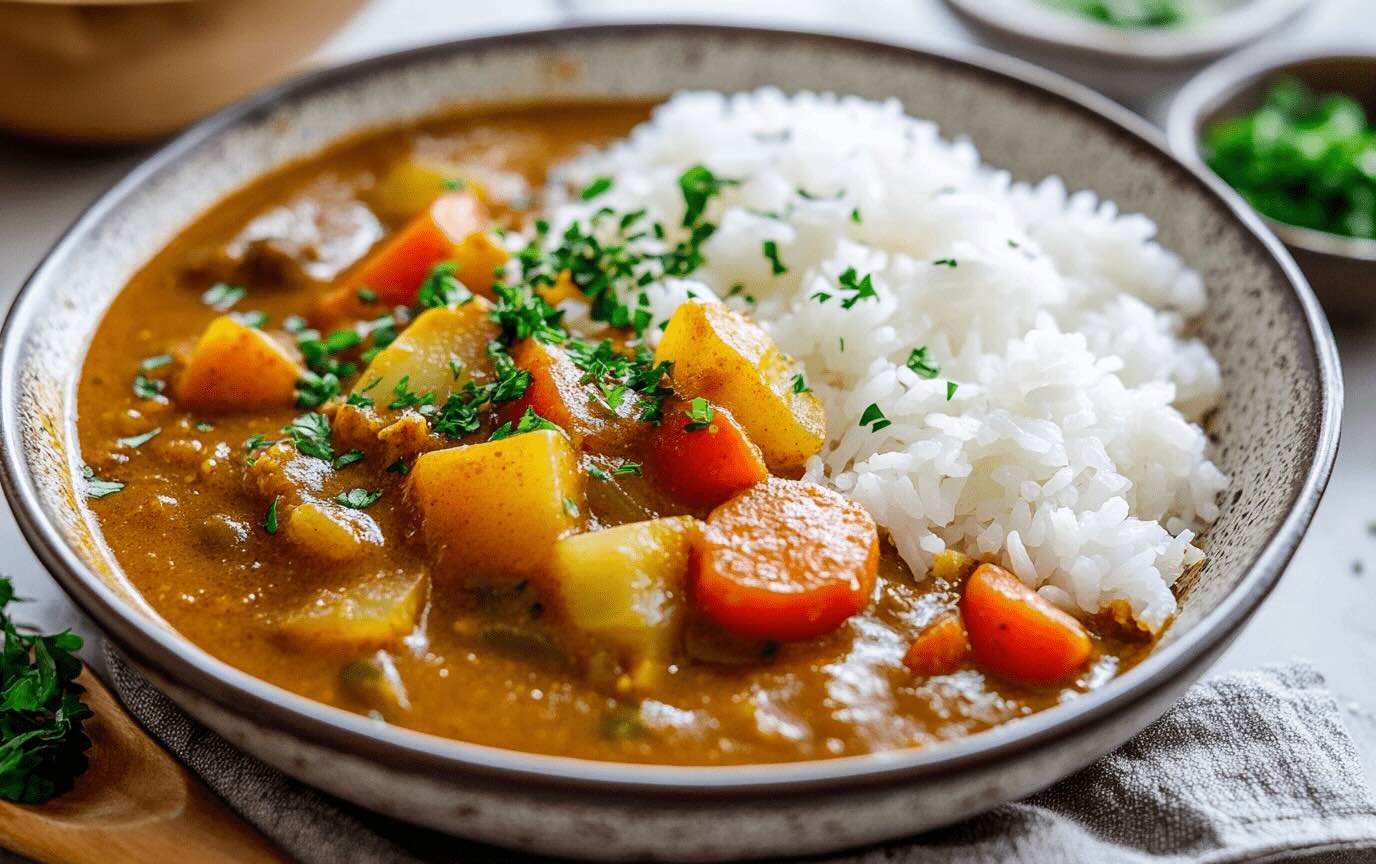Experience the comforting flavors of a Japanese curry with this vegetarian twist. This dish combines hearty vegetables with a rich, savory sauce, making it a perfect meal for any day of the week. Serve it over steamed rice for a satisfying and delicious dinner.
One key ingredient you might not have at home is the Japanese curry roux. This is a pre-made curry mix that comes in blocks and can be found in the international aisle of most supermarkets or at an Asian grocery store. It’s essential for achieving the authentic flavor and thick texture of Japanese curry.

Ingredients For Vegetarian Japanese Curry Recipe
Vegetable oil: Used for sautéing the vegetables, providing a base for the curry.
Onion: Adds sweetness and depth of flavor to the curry.
Carrots: Contributes a slight sweetness and texture to the dish.
Potatoes: Adds heartiness and helps thicken the curry as they cook.
Japanese curry roux: The key ingredient that provides the distinctive flavor and thick consistency of Japanese curry.
Water: Used to cook the vegetables and dissolve the curry roux.
Technique Tip for This Recipe
When sautéing the onion, ensure it becomes fully translucent before adding the carrots and potatoes. This step is crucial as it helps to develop a deeper, sweeter flavor in the curry. Additionally, when adding the Japanese curry roux, make sure to break it into smaller pieces before stirring it into the simmering mixture. This will help it dissolve more evenly and prevent any lumps, resulting in a smoother, more consistent sauce.
Suggested Side Dishes
Alternative Ingredients
vegetable oil - Substitute with olive oil: Olive oil provides a similar cooking medium with a slightly richer flavor.
vegetable oil - Substitute with coconut oil: Coconut oil adds a subtle sweetness that complements the curry spices.
onion - Substitute with shallots: Shallots offer a milder and slightly sweeter flavor, which can enhance the curry's taste.
onion - Substitute with leeks: Leeks provide a gentle onion flavor and a bit of texture variation.
carrots - Substitute with sweet potatoes: Sweet potatoes add a different kind of sweetness and a creamy texture.
carrots - Substitute with parsnips: Parsnips offer a similar texture with a slightly earthier flavor.
potatoes - Substitute with cauliflower: Cauliflower provides a low-carb alternative with a mild flavor that absorbs the curry well.
potatoes - Substitute with turnips: Turnips offer a similar texture with a slightly peppery taste.
japanese curry roux - Substitute with homemade curry paste: Homemade curry paste allows for customization of flavors and can be made with readily available spices.
japanese curry roux - Substitute with Thai yellow curry paste: Thai yellow curry paste provides a similar flavor profile with a bit more heat and complexity.
water - Substitute with vegetable broth: Vegetable broth adds depth and enhances the overall flavor of the curry.
water - Substitute with coconut milk: Coconut milk adds creaminess and a subtle sweetness that complements the curry spices.
Other Alternative Recipes Similar to This Dish
How to Store or Freeze This Dish
- Allow the vegetarian Japanese curry to cool to room temperature before storing. This prevents condensation and keeps the curry from becoming watery.
- Transfer the cooled curry into airtight containers. For portion control, consider using smaller containers to store individual servings.
- Label each container with the date of preparation. This helps you keep track of freshness and ensures you use the curry within a safe timeframe.
- Store the containers in the refrigerator if you plan to consume the curry within 3-4 days. The flavors will meld and often taste even better the next day.
- For longer storage, place the containers in the freezer. The curry can be frozen for up to 2-3 months without losing its rich flavor and texture.
- When ready to reheat, thaw the frozen curry in the refrigerator overnight. This gradual thawing helps maintain the integrity of the vegetables.
- Reheat the curry on the stovetop over medium heat, stirring occasionally to prevent sticking. You may need to add a splash of water or vegetable broth to adjust the consistency.
- Alternatively, you can reheat individual portions in the microwave. Use a microwave-safe dish, cover it loosely, and heat in 1-2 minute intervals, stirring in between, until thoroughly heated.
- If the curry appears too thick after reheating, adjust the consistency by adding a bit of water or vegetable broth and stirring well.
- Serve the reheated curry hot, ideally with freshly steamed rice or naan bread for a comforting meal.
How to Reheat Leftovers
Stovetop Method:
- Place the leftover vegetarian Japanese curry in a saucepan.
- Add a splash of water or vegetable broth to loosen the sauce.
- Heat over medium-low heat, stirring occasionally, until the curry is heated through and the vegetables are tender.
- Adjust the consistency by adding more liquid if needed.
Microwave Method:
- Transfer the curry to a microwave-safe dish.
- Cover with a microwave-safe lid or plastic wrap with a small vent.
- Heat on medium power for 2-3 minutes, stirring halfway through.
- Continue heating in 1-minute intervals until the curry is hot throughout.
Oven Method:
- Preheat your oven to 350°F (175°C).
- Place the curry in an oven-safe dish.
- Cover with aluminum foil to prevent drying out.
- Bake for 20-25 minutes, or until the curry is heated through.
Slow Cooker Method:
- Transfer the curry to the slow cooker.
- Set to low heat and cook for 1-2 hours, stirring occasionally.
- This method is perfect for a gentle reheat that maintains the integrity of the vegetables.
Double Boiler Method:
- Fill a large pot with water and bring to a simmer.
- Place a heatproof bowl with the curry over the simmering water, ensuring the bowl does not touch the water.
- Stir occasionally until the curry is heated through.
Instant Pot Method:
- Use the sauté function to reheat the curry.
- Add a splash of water or vegetable broth to prevent sticking.
- Stir frequently until the curry is hot and the vegetables are tender.
Best Tools for This Recipe
Large pot: Used for cooking the curry and simmering the vegetables.
Wooden spoon: Ideal for stirring the curry and ensuring the roux dissolves properly.
Chef's knife: Essential for chopping the onion, slicing the carrots, and dicing the potatoes.
Cutting board: Provides a safe surface for chopping and slicing vegetables.
Measuring cups: Used to measure the water accurately.
Vegetable peeler: Handy for peeling the carrots and potatoes if desired.
Stove: Necessary for heating the pot and cooking the curry.
Rice cooker: Convenient for making perfectly steamed rice to serve with the curry.
Serving spoon: Useful for serving the curry over the rice.
How to Save Time on Making This Dish
Prep ingredients ahead: Chop onions, carrots, and potatoes the night before to save time.
Use a food processor: Quickly chop vegetables using a food processor instead of doing it by hand.
Instant pot option: Use an Instant Pot to cook the curry faster, reducing simmering time.
Pre-made rice: Use microwaveable rice or cook rice in advance and reheat when serving.
Batch cooking: Make a larger batch of curry and freeze portions for future quick meals.

Vegetarian Japanese Curry Recipe
Ingredients
Main Ingredients
- 2 tablespoon Vegetable Oil
- 1 large Onion, chopped
- 2 medium Carrots, sliced
- 2 medium Potatoes, diced
- 1 block Japanese curry roux
- 3 cups Water
Instructions
- Heat the vegetable oil in a large pot over medium heat.
- Add the chopped onion and sauté until translucent.
- Add the sliced carrots and diced potatoes, and cook for a few minutes.
- Pour in the water and bring to a boil. Reduce heat and simmer until vegetables are tender.
- Add the Japanese curry roux and stir until dissolved and thickened.
- Serve hot with steamed rice.
Nutritional Value
Keywords
Suggested Appetizers and Desserts
More Amazing Recipes to Try 🙂
- Japanese Seafood Recipe35 Minutes
- Japanese Sardine Recipe30 Minutes
- Soki Recipe1 Hours
- Japanese Custard Cake Recipe1 Hours 20 Minutes
- Baked Japanese Curry Recipe1 Hours
- Japanese Crispy Rice Recipe30 Minutes
- Japanese Cheesecake Recipe1 Hours 20 Minutes
- Japanese Sticky Wing Recipe45 Minutes

Leave a Reply